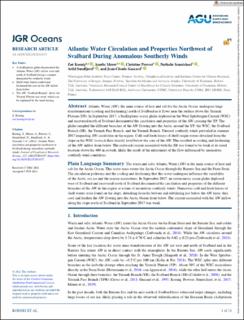| dc.contributor.author | Koenig, Zoe Charlotte | |
| dc.contributor.author | Meyer, Amelie | |
| dc.contributor.author | Provost, Christine | |
| dc.contributor.author | Sennéchael, Nathalie | |
| dc.contributor.author | Sundfjord, Arild | |
| dc.contributor.author | Gascard, Jean-Claude | |
| dc.date.accessioned | 2023-03-01T12:39:29Z | |
| dc.date.available | 2023-03-01T12:39:29Z | |
| dc.date.created | 2022-09-02T13:15:41Z | |
| dc.date.issued | 2022 | |
| dc.identifier.issn | 2169-9275 | |
| dc.identifier.uri | https://hdl.handle.net/11250/3054996 | |
| dc.description.abstract | Atlantic Water (AW), the main source of heat and salt for the Arctic Ocean, undergoes large transformations (cooling and freshening) north of Svalbard as it flows near the surface above the Yermak Plateau (YP). In September 2017, a SeaExplorer ocean glider deployed in the West Spitsbergen Current (WSC) and recovered north of Svalbard documented the circulation and properties of the AW crossing the YP. The glider sampled the different branches of the AW flowing into the Arctic around the YP: the WSC, the Svalbard Branch (SB), the Yermak Pass Branch, and the Yermak Branch. Unusual southerly winds prevailed in summer 2017 impacting AW circulation in the region. Cold and fresh lenses of shelf-origin waters detached from the slope in the WSC to reach their density level below the core of the AW. This resulted in cooling and freshening of the AW inflow from below. The eastward current associated with the SB was found to be weak at its usual location above the 400 m isobath, likely the result of the adjustment of the flow influenced by anomalous southerly wind conditions. | en_US |
| dc.language.iso | eng | en_US |
| dc.publisher | AGU | en_US |
| dc.rights | Navngivelse-Ikkekommersiell 4.0 Internasjonal | * |
| dc.rights.uri | http://creativecommons.org/licenses/by-nc/4.0/deed.no | * |
| dc.subject | Hydrografi | en_US |
| dc.subject | Hydrography | en_US |
| dc.title | Atlantic Water Circulation and Properties Northwest of Svalbard During Anomalous Southerly Winds | en_US |
| dc.type | Journal article | en_US |
| dc.type | Peer reviewed | en_US |
| dc.description.version | publishedVersion | en_US |
| dc.rights.holder | Copyright 2022 The Author(s) | en_US |
| dc.source.articlenumber | e2021JC018357 | en_US |
| cristin.ispublished | true | |
| cristin.fulltext | original | |
| cristin.qualitycode | 2 | |
| dc.identifier.doi | 10.1029/2021JC018357 | |
| dc.identifier.cristin | 2048305 | |
| dc.source.journal | Journal of Geophysical Research (JGR): Oceans | en_US |
| dc.relation.project | Norges forskningsråd: 276730 | en_US |
| dc.subject.nsi | VDP::Oseanografi: 452 | en_US |
| dc.subject.nsi | VDP::Oceanography: 452 | en_US |
| dc.identifier.citation | Journal of Geophysical Research (JGR): Oceans. 2022, 127 (6), e2021JC018357. | en_US |
| dc.source.volume | 127 | en_US |
| dc.source.issue | 6 | en_US |

